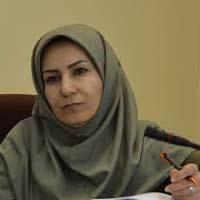Climate and Environmental Changes in Late Quaternary Using Clay Mineralogy in Gavkhoni Playa
The sediments of the Playa lake are sensitive indicators of local climates that any change in climate, hydrology, and sedimentary environment will cause changes in the physical and chemical properties of the sediments. These sediments create a valuable and important archive with high resolution to examine these changes in the past. One method of studying climate change during quaternary and often Holocene is the study of clay minerals in sedimentary cores harvested from wetlands and lakes. The study of clay minerals in these sediments can help to more accurately identify and re-read their past history and be used to determine the severity of weathering processes and also to investigate possible climate change. Clay minerals are highly efficient in hot and humid environments with high chemical decomposition, for detecting climate change, and in cold environments as a factor in identifying the source of sediments.
To perform this study, 16 sedimentary cores were harvested using a manual core drilling equipment with an average depth of 7 m and a maximum depth of 11.5 m from the sub sediments of the Gavkhoni playa and surrounding areas. The core was described based on texture, sedimentary structure, and layering characteristics, color, plant and shell remains, the type of evaporative crystals, and the relative degree of hardening of the sediments, and their chronological column was plotted. 90 samples from 9 sedimentary cores were prepared for X-ray diffraction analysis (XRD) and sent to the laboratory. Also, to extract the age of sedimentary sequences, three samples of C14-AMS bulk sedimentary materials were analyzed and calibrated with OxCal software (Bronk Ramesy, 2013) with an error range of 2 Sigma and confidence level of 95%.
The results of X-ray diffraction show that the sediments in the Gavkhoni playa in order of abundance contain clay ellite, chlorite, montmorillonite, and kaolinite deposits, respectively. They are also seen as the main minerals of quartz, calcite, feldspar, evaporative and dolomite minerals in graph peaks. According to the results of the metering analysis, the sedimentation rate in the western parts is about 0.4 mm per year and in the eastern parts is 0.25 mm per year. The clay minerals of Sepiolite, Polygorskite, and Kunzite have not been observed in sedimentary cores. These minerals are specific to the diagenetic environments, indicating no effect of very low effect of the conversion type of diagenesis in Gavkhoni playa deposits. Therefore, considering the assurance of the ineffectiveness of conversion diagenesis, it is possible to achieve long-term climate at different times. Ellite and chlorite minerals in the cores of the northern part of Playa are mainly due to the weathering of the basic masses of north Playa (koh siah) and the weathering of volcanic rocks and low-grade metamorphic rocks in the Urmia-Dokhtar zone. The presence of kaolinite and the increase of phonetic minerals, especially quartz, in the two cores of G-13 and G-11 at depths of more than 3 meters indicate the presence of high-volume river flows in the region, which indicates humid and warm climatic periods. The presence of montmorillonite and ilite in the central cores of Playa with the age of more than 25000, evokes cold and temperate conditions in the late Pleistocene era in the region. The high water period in the late Pleistocene (about 18000 years ago) is marked by the precession od shore lines to land in the G-11 core with the presence of kaolinite at depths of more than 4 m. The wet conditions have gradually decreased from about 18000 to 12000 years ago. During this period, kaolinite is replaced by montmorillonite, which indicates a decrease in rainfall compared to the previous period. The predominant minerals of the early Holocene in the Gavkhoni playa are the illite and chlorite, indicating semi-dry conditions. During this time, the Montmorillonite mineral can be observed in the G-2, G-4, G-11 and G-13 cores, which is in good agreement with the delta facies at a depth of 3 to 4 meters in the G-2 and G-4 cores. The existence of a dry period about 8000 years ago is evident by the increase in evaporative minerals, the absence of kaolinite and montmorillonite, and the spread of dune sands at a depth of about 2 to 3 meters in the cores of the western and central parts is evident. 4000 years ago, the northern cores (Zayandeh Rud estuary) showed wet conditions with the presence of montmorillonite, illite and chlorite. This situation has continued for about a thousand years, after which the conditions have become a bit drier with the increase in evaporative minerals. In general, relatively low water and dry periods can be identified by increasing the rate of evaporation and expansion of dune sands and high water and wet periods can be observed by increasing the amount of debris sands as well as kaolinite and montmorillonite minerals.
The climate of Gavkhoni region in the post-Pleistocene has been wetter than today. This situation has continued for the past 18000 years and has led to the precession of shore lines. Since then, the early Holocene (past 12000 years) has been marked by a gradual decline in coastal humidity and backwash. With the onset of the Holocene, dry conditions gradually developed and peaked about 8000 years ago. In the middle and late Holocene, suitable humidity conditions have been gradually created and a water environment has been formed in the northern part of Playa due to the entrance of Zayandeh rud river. This situation was dominated by semi-arid conditions about a thousand years ago, which was accompanied by an increase in the evaporative deposits.
- حق عضویت دریافتی صرف حمایت از نشریات عضو و نگهداری، تکمیل و توسعه مگیران میشود.
- پرداخت حق اشتراک و دانلود مقالات اجازه بازنشر آن در سایر رسانههای چاپی و دیجیتال را به کاربر نمیدهد.



